Looking around today’s world, it’s hard to imagine what the next “big thing” might be. Is it Elon Musk’s re-imaging of the entire automobile industry or efforts like his and Richard Branson’s efforts to bring humanity towards Space? Perhaps it’s something much smaller, such as the recent proliferation of drones and smartphones. One thing is for certain; head back to 1880, and it would have been hard to imagine what the three competing inventors in Stuttgart would have produced in a short time. When the first production automobile was unveiled to the public, it was – in fact – far from a guarantee of propulsion. The number of hurdles which Benz and others had to leap in order to create the car boggles the mind. Two recent programs bring this to light; Drive recently did a special on Germany where they highlighted Bertha Benz – the real power behind Karl Benz’s invention – and her 120 mile drive to her home village from Mannheim. The other was a classic race undertaken by Wayne Carini on Chasing Classic Cars when he drove in the Veteran Car Run from London to Brighton. That was significant for a few reasons; it commemorates the ruling that so-called “light locomotives” (read: cars) no longer had to be preceded by a man walking and waving a flag to alert motorists, capping their speed ostensibly at 4 m.p.h.. This ruling took place in 1896, a full decade after the car was introduced – and to commemorate, a few motorists sped along at 14 m.p.h. – the new limit – for the 60-odd mile run with a few light slopes to the seaside community of Brighton. Mr. Carini’s journey didn’t go particularly smoothly, suffering multiple breakdowns and even with full support of a team of mechanics, they couldn’t ultimately make it. It highlighted how far cars have come, but underscored even more greatly the achievement of Bertha Benz, who drove with her two sons in what was an even more primitive design over a distance twice as far as Carini. There was no support team. Not only that, there was no anything – no mechanics, no service stations or gas stations, no cell phones, no navigation. Mrs. Benz needed to repair the car herself, and along the way managed to unintentionally create brake linings and reportedly also suggested the first multi-gearbox to assist in climbing some steep hills, since apparently children had to push her up some slopes. With no gas stations – and, in reality no gasoline, either – Mrs. Benz stopped at the local drug stores to pick up turpentine to feed her husband’s creation. The challenges that these early pioneers undertook were simply amazing, and they set the stage for what would become not luxury item for the rich, but a necessity of the modern world:
CLICK FOR DETAILS: 1886 Benz Patent Motorwagen on eBay
Year: “1886”
Model: Benz Patent Motorwagen
Engine: 1.0 liter single-cylinder
Transmission: Single-speed
Mileage: 0 mi
Price: Reserve Auction
1886 Mercedes Benz Patent Motor Wagon
This motor wagon is one of very few being offered for sale. It is in excellent condition and has never been started since it was delivered to the Mercedes dealership it came from. Each Mercedes Benz dealer had the chance to own one of these when they were being offered we had 2 of these wagons one of which was sold to a museum a few years back and now the owner has decided to sell the last and final one we have. This wagon was issued by Mercedes Benz, not to be confused with some of the non-authentic wagons being offered on the market. This is a rare opportunity to purchase a collectors item that was never offered to anyone who was not a Mercedes Benz dealer.
The first stationary gasoline engine developed by Carl Benz was a one-cylinder two-stroke unit which ran for the first time on New Year’s Eve 1879. Benz had so much commercial success with this engine that he was able to devote more time to his dream of creating a lightweight car powered by a gasoline engine, in which the chassis and engine formed a single unit. The major features of the two-seater vehicle, which was completed in 1885, were the compact high-speed single-cylinder four-stroke engine installed horizontally at the rear, the tubular steel frame, the differential and three wire-spoked wheels. The engine output was 0.75 hp (0.55 kW). Details included an automatic intake slide, a controlled exhaust valve, high-voltage electrical vibrator ignition with spark plug, and water/thermo siphon evaporation cooling.If you have any additional questions or would like more photos and information on the Mercedes please feel free to call or text me. My name is Larry Minor and my cell is (540) 748-2016.
Mercedes-Benz has twice reissued the Patent Motorwagen as a celebration of their namesake’s creation, and apparently dealers had the option to buy these examples to put on display. Occasionally these come up for sale; one sold in Europe a few years ago for around a reported $87,000. Bidding on this example has not been as active despite the pristine shape. Currently priced at $32,000, ironically it’s very close to the inflation-corrected original purchase price, which equated to around $25,000. Not many are interested in anything other than seeing them, but the chance to own an original automobile – even a recreation of one – is a rare and surprisingly affordable opportunity.
-Carter

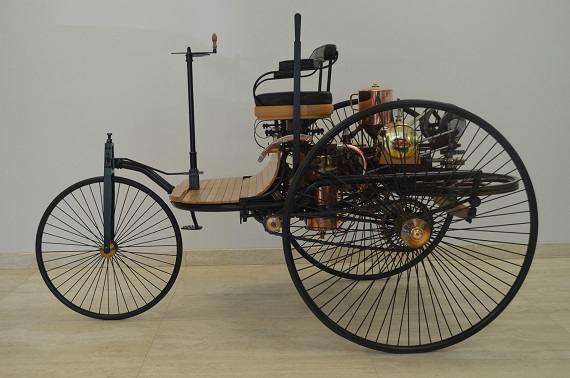
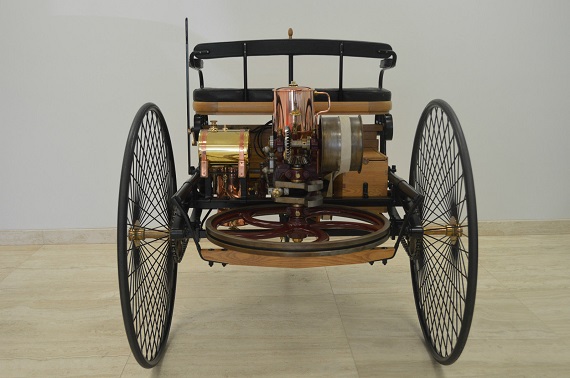
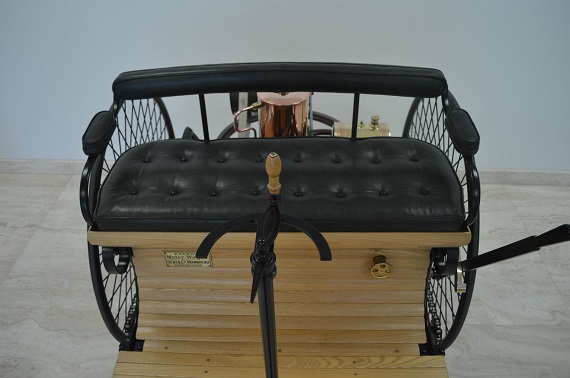

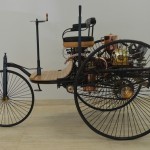


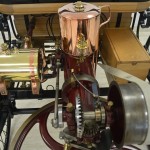

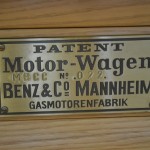
46″ dubs whaaaa